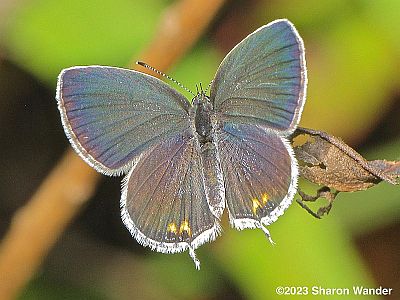New Jersey Butterfly Club
A chapter of the North American Butterfly Association (NABA)
Eastern Tailed-Blue
Everes comyntas
Identification: Tiny—<1". Sexes similar below. Above: Male FW and HW deep blue with dark borders and small orange spots near HW tails. Female is similar, but dark gray, and orange spots are more prominent. Below: Pale gray with many small dark spots on both wings, and HW with 2 orange spots near very thin, hairlike tail (tail visible only at fairly close range). Similar species: Azures are usually lighter blue above, lack orange spots on HW, and lack tails. Gray Hairstreak—which is occasionally seen open winged—is larger, has a larger orange spot on HW, 2 longer, more-obvious tails, and a small orange spot on head.
NJ Status and Distribution: Resident. Common and widespread.

Habitat: Dry or wet meadows, and other open places, including disturbed areas.
Flight Period: Several broods resulting in an extended flight from early April to late October. Extreme dates: North Jersey 4/1—11/8; South Jersey 3/17—12/14.
Caterpillar Food Plants: Many legumes including clovers (Trifolium), ticktrefoils (Desmodium), Lespedezas, and sweet clovers (Melilotus).
Overwintering Stage: Mature caterpillar.
Good Locations: Anywhere and everywhere.

Male, New Providence, Union Co., NJ, 5/24/21.

Female, Delaware Water Gap NRA, Sussex Co., NJ, 8/24/12.

Lakehurst, Ocean Co., NJ, 6/18/05.

Female ovipositing on buds of White Clover (T. repens).

Red Clover (Trifolium pratense). This common, non-native clover is one of many species of legumes used as a host plant by Eastern Tailed-Blue.

Roundhead Lespedeza (L. capitata), one of the many Pea Family species used as caterpillar food plants by Eastern Tailed-Blue.